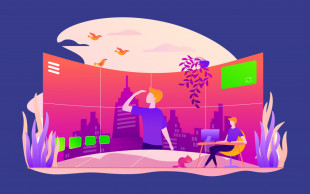For those of us who spent 12 years of our lives in school, what more is there to learn? Aren’t careers just putting into practice what we have already learnt? While that may be true, our careers expose us to new, challenging situations that can’t be solved with our current knowledge. Work environments tests many different aspects of a person’s skills by putting employees out of their comfort zones. Besides, the world is changing. Everyday something new is discovered and the old becomes obsolete. You might say to yourself, “I’m too old to learn”, but that isn’t true. With the correct understanding of learning, the different tactics to tackle learning and applying knowledge to your advantage, you are certain to reap the best benefits of learning.
What is Learning?
Learning is defined as acquiring knowledge or skills through experience, study or being taught (Merriam Webster, 2017). Through this definition, itself, we can conclude that there are 3 routes to learning. One is through firsthand experience, something you yourself become involved in, or through secondhand experience, something you see others involve in that teaches you a new lesson. Second, is through studying materials such as books, videos and pictures or studying our surroundings such as people, societies and cultures. Most of our information knowledge is acquired through materials whereas behaviours, ethics and principles are usually acquired from the environment.
Now it is crucial to understand that learning is for everyone. There might be different degrees to how fast someone can absorb information and how much knowledge they can acquire at one time, but regardless, everyone can do it. Being slower or having difficulty to grasp information does not make a person unable to learn.
The Process of Learning
Different disciplines of study have different takes on how we process information. The biological approach states that every time we learn something, a new neural connection is formed in our brains. The information we input into the brain is stored in our memory space and can be retrieved anytime we need it. A simple analogy is to imagine a computer. We input information on a keyboard which is then stored in the hard disk. The information can be easily retrieved on the monitor when it is called for.
Kolb (1974) had a more cognitive approach. His theory of experiential learning style suggests that the learning process is made up of four stages:
-
The first stage is the Concrete Experience, which is defined as being involved or seeing an event unfold that teaches the observer.
-
The second stage is Reflective Observation, which is to reflect on the experience and note any inconsistencies between the experience and our own understanding.
-
Followed by, Abstract Conceptualization. This stage causes the person to come up with a new idea or gain new knowledge based on the reflection done in the previous stage.
-
The last stage is Active Experimentation, which is to apply the new knowledge learnt from the experience.
Why Do We Have To Learn?
Change can be scary but you know what’s scarier? Allowing fear to stop you from growing, evolving and progressing – Mandy Hale
For some of us change is difficult, nevertheless it is inevitable. Altering and improving ourselves through learning can do wonders for our career as well as take us to new heights even we thought impossible.
It Helps to Increase Your Skillset
Most of us looking to expand our careers, are usually proficient in the courses we have already learnt at school. However, employers are looking for more than that. Through continuous learning and gaining new experiences, we gain essential skills that allow us to be adaptable to any job. Whether it be writing reports, balancing checkbooks or analysing finances, employers are interested in employees who can do it all.
It Creates Better Productivity
Our usual methods of working, whether it be marketing, hiring or sales, are comfortable and might seem effective to us. Nonetheless, when we open ourselves to new concepts, tools and technology, we allow for better productivity. 20 years ago, the best marketing scheme were huge billboards but now it has shifted to brightly coloured advertisements that pop up on your phones. Using machines for packaging has proven to be 30 times more efficient than human labour. If we refuse to learn, we close ourselves to good opportunities and high profits.
It Increases Our Capability in Taking Up More Tasks and Responsibility
In all job environments, employers are usually curious to know if employees are able to handle any and all situations. Even if it is for the first time, you can learn to do anything and if you persevere, you can surely succeed. By proving your worth in different areas of expertise, employers would be more willing to give more tasks and responsibilities to you. This also opens doors for higher positions and new business ventures.
If all of the above is not enough to convince you on how learning changes your life, take the case of Richard Branson. He dropped out of high school at the age of 16. He knew nothing about the music or airline industry. In fact, the company name “Virgin” was used because he was new to the business industry. Yet, by learning continuously and working hard, he managed to build one of the largest airline industries in the world. Today Branson is worth $5.1 billion.
How Do We Learn?
I can't change the direction of the wind, but I can adjust my sails to always reach my destination - Jimmy Dean
Our traditional methods of learning through rote memorization and practice tests are not going to be effective in the working world. It might get you the certificate but it will not guarantee a successful career. Hence to keep up with the rat race of life, there are some tweaks and tricks you could do to learn better.
The VARK Model
Fleming and Mills (1992) proposed the VARK model. They believed that there are significantly different ways that people absorb information. Their theory states that there are 4 sensory modalities that learners use to glean information, which are visual, auditory, reading/writing and kinaesthetic (VARK).
Visual learners prefer pictures, diagrams and charts. They grasp information better when it is placed clearly in boxes and symbols, patterns or arrows are used to show the relationship between different things. A visual learner should constantly use mind maps and reimagine information into charts or pictures.
Auditory learners prefer hearing the information. They learn best when details are given through recordings, lectures or through group discussion. They also like to voice out information because hearing themselves helps them remember. An auditory learner should always record the audio of meetings and lectures to keep up.
Reading or writing learners easily gain information just through interacting with text. They learn fast when information is displayed via text. Although to enhance this method of learning, learners should write facts in summarized or point form. They also work better when words are displayed in brightly coloured sticky notes or in PowerPoint presentations.
Kinaesthetic learners love to jump into action. They grasp better when they can experience the knowledge or practice it. These types of learners might be clumsy in their first few attempts but will improve with practice. Their best attribute is that they are eager to do the job.
Find out what type of learning best suits you with the VARK model test.
Mental Tools
Barbara Oakley Ph. D, of Oakland University proposed simple methods of how people could use their brains effectively to learn.
Modes of Thinking
According to Oakley, our brain undergoes 2 different modes whenever we learn, which are the focused and the diffuse mode. The focused mode brings our attentiveness to a particular subject but it wears out quickly, and soon the brain stops working. The diffused mode is a relaxed state where the brain reviews the information that we take in during the focused mode. To deny our brain the diffuse mode will cause the information we learn to be forgotten quickly as well as any new concepts the brain might conjure. Oakley suggests the best way to retain information is to learn as much as we can. Once we exhaust the brain, we should take a 5-10 minute nap that would allow the brain to re-enter the focused mode again.
Chunking
Oakley also suggests practicing chunking which is to remember bits of information as meaningful chunks. A fairly straightforward example of chunking is how we remember numbers in 3-digit or 4 digit groups. For example, 555-738-2990. To learn more complex information, assosciate all basic parts of related information as one chunk. For example if you plan to learn Microsoft Excel, group together basic components, sub components and when to use them as one chunk. Our brain remembers information as a network model so the more related the ideas, the easier to remember.
Spaced Repetition
This concept works in the simple way of retaining information by recalling over a period of time. Every time you learn new information, try and recall it again. The next day recall it again. If you fail, go back and review what you have forgotten. At the same time continue to learn more information. After 3 days recall the information again. Widen the gap of recall to 1 week, 3 weeks, 2 months and more. If you fail anytime along the way, recall the information more frequently until you feel confident to widen the duration. This method allows the memory to be reinforced into the brain until it is no longer forgotten. Computer programmes like Anki provides this service by timing recalls and reminding users to recall.
Live as if you were to die tomorrow, learn as if you were to live forever – Mahatma Gandhi
Learning is lifelong. It is a skill we need to continue to survive in this everchanging world. But is not difficult if we use the right methods. Through learning, we can better equip ourselves to adapt to any situation be it at our workplace or our personal lives. As the saying goes, never stop learning because life never stops teaching.
To learn more on mental tools, you can sign up for Oakley’s course, Learning How to Learn: Powerful Mental Tools.
REFERENCES
McLeod, S. (2013). Kolb - Learning Styles.
Retrieved from https://www.simplypsychology.org/learning-kolb.html
The VARK Modalities. (2017).
Retrieved from http://vark-learn.com/introduction-to-vark/the-vark-modalities/
Bolton, S. (2015). Richard Branson: How to start a business with no experience.
Retrieved from https://www.virgin.com/entrepreneur/richard-branson-how-start-business
-no-experience
Learning How To Learn. (2015).
Retrieved from https://www.cocc.edu/uploadedfiles/teaching_commons/events/
videos_of_past_events/learninghowtolearn_kendacaligure_20150213.pdf
















